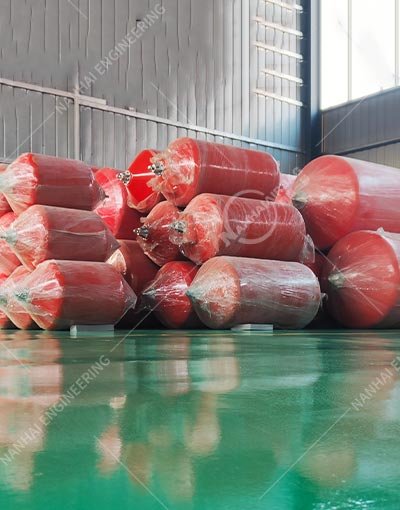Why Yokohama Floating Fenders Are the Gold Standard for Marine Protection
05/06/2025Yokohama Fenders: The Marine Industry’s Trusted Shield Against Costly Collisions
12/06/2025

Foam filled fenders are marine safety devices made of a tough outer rubber layer wrapped around a dense, lightweight foam core. Unlike solid rubber fenders, their hollow, air-and-rubber design compresses on impact, absorbing kinetic energy from ship collisions. Commonly used in busy harbors, marinas, and offshore terminals, they’re the go-to choice for protecting large vessels and sensitive docks.
Why This Matters: When Ports Can’t Afford “Close Calls”
Imagine a windy afternoon at a coastal marina. A 300-foot yacht drifts sideways, its hull slamming into a wooden dock. Without foam filled fenders, the impact could:
- Crush the dock: Replacing wooden pilings costs tens of thousands of dollars.
- Tear the yacht’s hull: Repairs could top $100k for a luxury vessel.
- Spill fuel: A single rupture could dump 1,000+ gallons of oil into the water, killing marine life for miles.
This isn’t hypothetical. In 2020, a ferry in the Mediterranean collided with an unprotected jetty, causing a 3-day port closure, $5M in damages, and a 2-week fuel cleanup. Here’s the urgent truth:
- Rising Ship Sizes: Modern cargo ships can weigh over 20,000 tons—their collisions pack the force of a small earthquake.
- Busy Waterways: Ports like Shanghai and Rotterdam handle 100+ ships daily; one accident can cripple global supply chains.
- Environmental Rules: Stricter regulations now penalize ports for spills, making prevention non-negotiable.
Ports and marinas need foam filled fenders to avoid disasters—and keep their doors open.
🚢 How Do Foam Filled Fenders Work?
Think of them as industrial bubble wrap for ships. When a vessel docks, its hull presses against the fender. The soft rubber exterior conforms to the ship’s shape, while the foam core compresses, spreading the impact energy across the fender’s surface. This “cushion effect” reduces peak force by up to 80%, preventing:
- Dock Damage: No more cracked concrete or splintered wood.
- Ship Scrapes: Protects hulls, propellers, and cargo from costly dents.
- Injuries: Softens blows to workers or bystanders near the dock.
Pro Tip: Install them at a 45-degree angle to maximize energy absorption during angled collisions.
🌟 Why Foam Filled Fenders Beat the Competition
While solid marine rubber fenders work for small boats, foam filled fenders are built for big ships and tough conditions:
- Lightweight Yet Powerful: Their air-and-rubber design makes them easy to install but tough enough to handle 50,000+ pound impacts.
- Saltwater Proof: The rubber coating resists corrosion, UV rays, and barnacles—no rust or degradation.
- Versatile: Perfect for crowded harbors (they don’t need much space) and rough waters (they adjust to waves).
Example: The Port of Los Angeles uses foam filled fenders to protect its massive container ships, reducing repair costs by 60% in just 2 years.
🌊 Where Are Foam Filled Fenders Used?
- Commercial Ports: For tankers, cruise liners, and bulk carriers.
- Marinas: Safeguarding yachts, ferries, and fishing boats in tight slips.
- Offshore Rigs: Absorbing impacts from supply ships in rough seas.
💡 Top Benefits of Foam Filled Fenders
- Save $100k+ Per Accident: Prevent one collision and avoid dock repairs, hull fixes, and fines.
- Eco-Friendly: Cut fuel and oil spill risks by 90%, protecting marine ecosystems.
- Low Maintenance: No rust, no rot—just occasional cleaning keeps them going for 15+ years.
🔍 People Also Ask (Related Questions)
- “Are foam filled fenders the same as marine rubber fenders?”
No—solid marine rubber fenders rely on thick rubber alone to absorb impacts, while foam filled fenders use a lightweight foam core for better energy dissipation, especially with large ships. - “Do foam filled fenders work in cold water?”
Absolutely. The rubber coating stays flexible in freezing temperatures, and the foam core retains its shock-absorbing properties. - “How long do foam filled fenders last?”
With proper maintenance (cleaning, inspecting for tears), they last 15–20 years—even in harsh saltwater environments. - “Can I install foam filled fenders myself?”
We recommend hiring professionals. Incorrect placement (e.g., wrong angle or spacing) can reduce their effectiveness by 50% or more. - “Are they expensive?”
Initially, yes—but they save far more over time by preventing collisions, repairs, and fines.
🛠️ Ready to Protect Your Harbor?
Foam filled fenders aren’t just a “nice-to-have”—they’re a lifeline for modern ports. Whether you’re managing a bustling commercial terminal or a cozy marina, these fenders shield your assets, the environment, and lives.
Need help choosing the right size or type? Our experts are here to answer your questions—drop them below or reach out today. 👇
